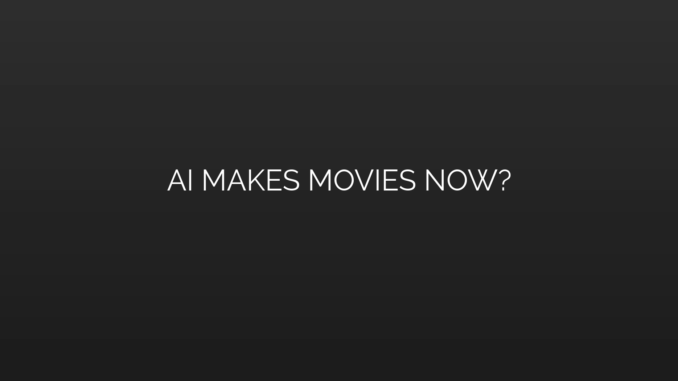
The Rise of AI in Filmmaking: A Revolutionary Shift
For decades, human creativity has been the undisputed engine of filmmaking. From Hitchcock’s suspenseful narratives to Spielberg’s visual spectacles, cinema remained a deeply human craft. Yet today, we stand at an unprecedented inflection point: AI in filmmaking is transitioning from experimental novelty to a transformative force. Artificial intelligence now touches every phase of movie creation—scriptwriting, visual effects, editing, and even acting—raising profound questions about creativity, ethics, and the future of entertainment.
How AI Reshapes the Filmmaking Pipeline
The integration of machine learning in film isn’t a distant fantasy. It’s already disrupting traditional workflows:
PreProduction: Conceptualization and Scriptwriting
- AI screenwriting tools like ChatGPT and Sudowrite analyze vast databases of scripts and literature to generate dialogue, plot structures, or entire scenes. Films like Sunspring (2016) demonstrated early AI-written scripts, revealing both the potential and limitations of algorithmic storytelling.
- Predictive analytics forecast box office success, allowing studios to greenlight projects based on AI-driven market analysis.
- Casting algorithms scan actors’ past performances and audience reactions to recommend ideal candidates.
Production: Visuals and Performance
- Generative AI in entertainment crafts hyper-realistic backgrounds and characters. Tools like OpenAI’s DALL·E and MidJourney design concept art, while deep learning for video refines motion capture and CGI. For example, The Mandalorian used AI-enhanced LED screens to create immersive virtual sets in real time.
- AI-driven cameras autonomously adjust framing and lighting by analyzing actor movements, reducing technical overhead.
PostProduction: Editing and Enhancement
- AI algorithms streamline editing by identifying optimal cuts, syncing audio, and enhancing resolution. Adobe Premiere Pro’s Auto Reframe uses machine learning in film to adapt footage for multiple aspect ratios.
- Deepfake technology alters performances or de-ages actors—seen in The Irishman and Rogue One—though this sparks ethical debates about authenticity.
Case Studies: From Short Films to Blockbusters
While no studio has yet released a fully AIgenerated feature film, pioneering experiments hint at the future:
- “The Frost” (2023): A 5-minute short film created entirely by generative AI tools (MidJourney, ChatGPT, Runway ML), showcasing autonomous world-building.
- Wes Anderson’s “Star Wars” Trailer: A viral fan-made project using AI to mimic Anderson’s aesthetic, proving how style transfer algorithms democratize directorial techniques.
- Major studios leverage AI for efficiency: Warner Bros. uses Cinelytic for film financing decisions, while Netflix employs algorithms to optimize content delivery.
The Ethical Tightrope: Creativity, Labor, and Control
As AIgenerated movies advance, they ignite critical debates:
- Creativity vs. Automation: Can AI truly replicate human emotion and originality? Critics argue that algorithmic stories lack depth, risking homogenized narratives.
- Job Displacement: From voice actors to editors, guilds warn of widespread unemployment. The 2023 Hollywood strikes underscored demands for guardrails against AI replacing roles.
- Ethical Implications of AI Movies: Deepfakes threaten consent and misinformation. Imagine an actor’s likeness reused posthumously—or manipulated maliciously—without permission.
- Copyright Landmines: Who owns an AI-produced script or character? Courts grapple with assigning authorship when algorithms generate content from copyrighted training data.
The Future of Filmmaking: Partnership or Takeover?
Predictions vary widely, but consensus points toward synergy rather than replacement:
1. Hybrid Workflows:
- Human directors will leverage generative AI in entertainment to rapidly prototype ideas.
- Editors will use AI for technical tasks, reserving creative decisions for artists.
2. Democratization:
- Indie filmmakers gain access to VFX and editing tools once limited to big-budget studios.
- Platforms like TikTok and Runway ML enable amateurs to create cinematic content with minimal resources.
3. Audience Evolution:
- Personalized films could emerge—AI-tailored endings, characters, or themes based on viewer data.
- Interactive storytelling (e.g., Netflix’s Bandersnatch) will scale via deep learning for video.
Navigating Uncharted Territory
AI in filmmaking demands proactive solutions:
- Regulation: Governments and guilds must establish laws protecting IP, consent, and labor rights.
- Transparency: Studios should disclose AI usage, much like nutrition labels for creative content.
- Education: Film schools must integrate AI literacy to empower future creators as “augmented artists.”
Conclusion: The Human Director in the AI Era
The question isn’t whether AIgenerated movies will exist—it’s how humanity will guide their evolution. Films are cultural artifacts reflecting our collective dreams, fears, and identities. While machine learning in film offers efficiency and innovation, it cannot replace the irreplaceable: human intuition and emotional truth. The future belongs to filmmakers who harness AI as a collaborator—inspiring unprecedented art without erasing the soul of storytelling.
In this transformative age, one axiom endures: technology amplifies creativity, but imagination remains inherently human. The curtain has risen on a new act in cinema’s history, and the next scene is ours to write—algorithm or not.

Leave a Reply